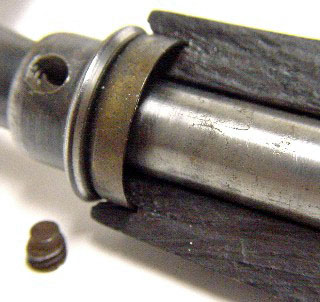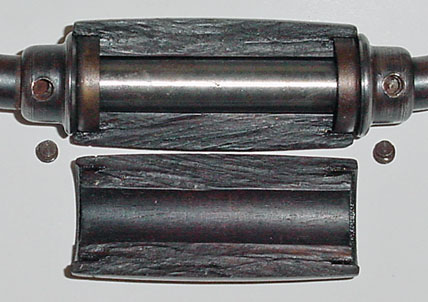PEXTO Braces - Another Type Study of Sorts
by George Langford
March 2, 2008 - Updated September 29, 2016
| Group I - The Peck & Powers chuck as described in the US Patent No.212,110 summarized at left was extremely rugged and so is rarely found damaged with missing jaws. Good thing - it is rather difficult to get the jaws out when the chuck has the retaining screw that Pexto added to keep the jaws inside the chuck. The earliest jaws, which had no such retention screw, can be taken out easily. See PEXTO-13; price $30.00 Some of the Peck & Powers chucks have had their shells burst by overtightening; they do not self-tighten like modern three-jaw chucks, so the damage is not the result of driving a bit too vigorously. Others tried to improve on chucks with this outward design having individual jaws pivoting on a threaded block (No.258,764, by William Ives and No.288,748 by John Watson), jaws loosely connected to a threaded block (No.275,860 by Elmon Rose), jaws with threaded integral semi-blocks (No. 306,900 by Richard Johnson), jaws sliding in channels cut into the spindle (No. 461,617 by Obed Peck), jaws spread apart by leaf springs (unpatented chuck made by John S. Fray Company), or even using the Fray jaws with ball bearings (No.904,501 by Joseph Peck Bartholomew). The John S. Fray Company sold braces with the version of the jaws illustrated in US Patent No.904,501 much earlier than the May 16, 1908 date of that patent, but I have not been able to find any patent that claimed those jaws. After Fray was bought out by the Stanley Works, Stanley continued to make braces with such jaws for many years. The Bartholomew patent was assigned to the Stanley Rule & Level Company, but the jaws and their springs are not mentioned in the claims. I have a six-inch swing brace with the patent date and early (no screw) configuration of this chuck (Feb.11,1879) as well as the common version of the Reising ratchet and its patent date of Dec.30,1884. That would make it a Group I-IV brace. See PEXTO-15, price: SOLD. I also have a couple of braces with these jaws and the Ellrich patent ratchet, a Group I-III brace: PEXTO-09, price: $40.00 and PEXTO-10, SOLD. |
|||||||||||
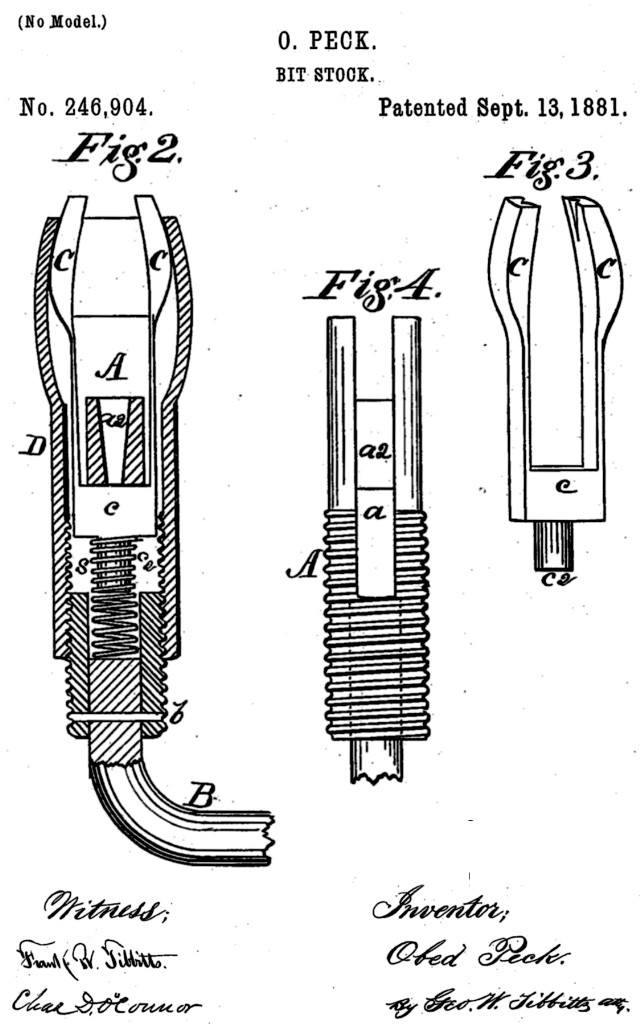 |
Group II - The first really good set of brace jaws (after Nelson Spofford's) was invented by William Henry Barber in 1864. The Barber jaws were plagued by spring problems, and so Obed Peck invented the improved version of Barber's jaws (after the Barber patent had expired) in US Patent No.246,904 illustrated in summary form at left. Henry Stevens (in US Patent No.229,197) had already invented a little sleeve to stiffen the spring, but Peck combined the stiffening element with the jaws themselves, thereby reducing the number of pieces that can get lost. John Fray even got in on the act by patenting a Barber-like arrangement with both a peg and a sleeve, in US Patent No.304,519. Peck's spring was installed by slipping it up inside the base of the spindle base before pinning the spindle to the bow. Consequently, when repairs are required at a later time, it requires quite a struggle to wiggle a replacement spring into the chuck. The jaws themselves can be put in through the hole marked "a" in Figure 4 at left with one leg through hole "a" and the other leg straddling the integral block "a2" before springing the jaw assembly into its final position. The actual Peck jaws are made in one, long flat piece and then bent into the necessary "U" shape, with the peg "c2" finally riveted into the middle of the "U." There is just the one brace in my collection with just this patented chuck: PEXTO-18. I have one very early Pexto brace (PEXTO-19) that has this Peck jaw design as well as the Reising patent ratchet mechanism of the Group IV braces, so the development of Pexto braces was not all that linear over time. I also have one of the first Millers Falls braces that was made by the predecessor firm of Gunn, Amidon, and Saxton of Greenfield, Massachusetts. It is marked, "MANUFACTURED BY G.A.&S./GREENFIELD, MASS." and "PATENTED MAY 24, 1864." That brace originally held a set of Barber patent jaws, but when I got it, the jaws were missing. I was able to replace them with a set of Peck jaws and spring which I shoehorned in with only a little bit of adjustment (to the jaws only) with a file. |
||||||||||
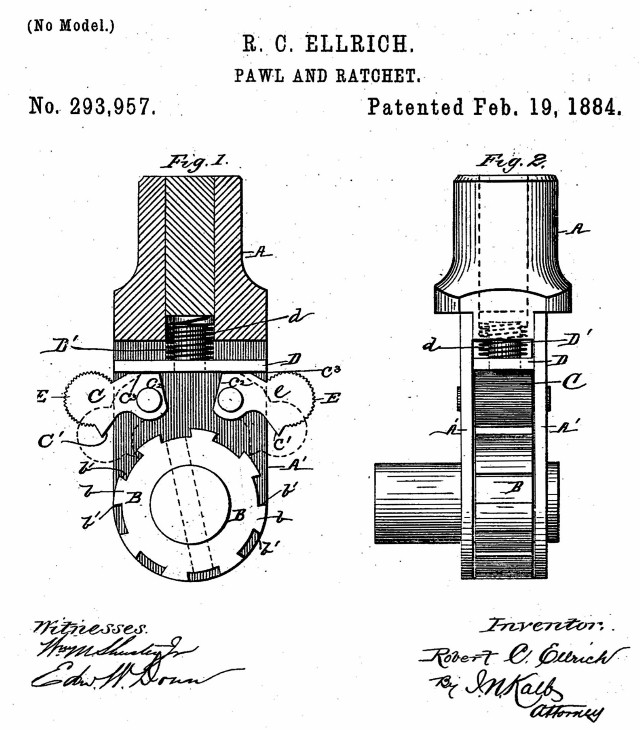 |
Group III
- The earliest braces in this series were made with the latch-pawl design shown at left, invented by Robert Ellrich and granted on February 19, 1884. While both this patent and the H.V.Smith patent were in force, the Ellrich patent date was stamped on the ratchet housing and the Smith patent date was marked on the shell of the chuck. This was the case for only the years, 1895 through 1901. After 1901 the Ellrich patent date was no longer put on the braces. These ratchets work smoothly and with less drag than the ratchets on the "generic" braces that were made by many other manufacturers for a while, once everyone's patents had run out. The Ellrich ratchets are rugged and rarely fail, even though the driving force is borne in shear at each end of the active pawl's pivot pin. The pawls themselves were at first made somewhat like the drawing, albeit with a less pronounced crown and coarser serrations. Later, they were made with a fingernail-breaking lip. A handy feature is the ability to lift both pawls out of the way so that the spindle free-wheels. That's useful for starting screws. Later, Pexto experimented with a ratchet design using two pawls just like these, except that there are two weaker coil springs, one located directly behind the flat base of each pawl, and no flat follower like the one in the Ellrich patent. The two coil springs have the same orientation as the Ellrich spring, but they are contained inside a widely spaced pair of holes just under the surface of the housing. That brace has the Peck chuck. Its ratchets work with even less drag than the Ellrich ratchet. Most of the P.S.&W.Co. braces listed in the table below have the H.V. Smith ball bearing chucks of Group VI and also have the Ellrich ratchet of Group III. PEXTO-20 (Price: $50.00) has both of the immediately preceding patents, including their inscribed issue dates.
|
||||||||||
| Group IV - These braces have those cute little twin gearshift levers. They're sometimes marked with a patent date of Dec. 30, 1884. The patentee is Caspar Reising. The late Chuck Zitur reminded me in the OldTools List that the patent, No.309,876, was indeed assigned to Peck, Stowe & Wilcox Co. Two other brace patents were issued that same day: No.309,902 (John Watson) and No.309,887 (Amos Shepard). The latter patent was assigned to the Peck Stow & Wilcox Company just like Caspar Reising's patent. Caspar must have really ticked off someone,because this patent isn't mentioned in Ron Pearson's The American Patented Brace 1829-1924, in Jim Prices's 6/24/02 CDROM on Patent Images of Braces & Auger Bits, and not in The Directory of American Toolmakers, edited by the late Bob Nelson. Finally, even the fine DATAMP tool-patent compendium somehow missed Caspar's invention. What's more, Peck, Stow & Wilcox didn't follow the patent, whose claims mention only one little shelf on which to stow the unused pawl lever. The actual brace uses two shelves, because that permits both ratchets to be stowed, allowing the spindle to spin freely, as during the starting of a screw. I have one brace that Pexto made that does actually follow the Reising patent (PEXTO-17) with Peck jaws, making it a Group II-IV brace. See also PEXTO-15, a six-inch-swing brace, SOLD. |
|||||||||||
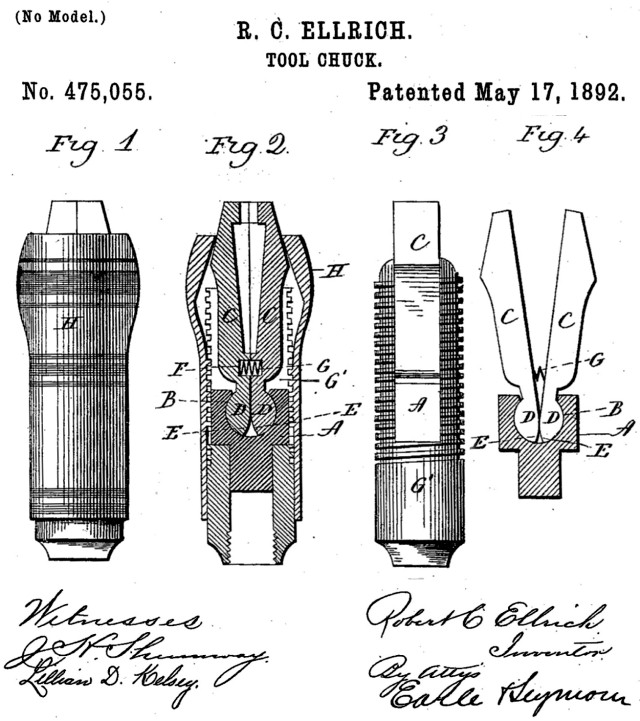 |
Group V - I have a Pexto brace marked, "PAT. MAY 17, 1892," which has the Peck & Powers chuck mechanism of Group I and the Ellrich patent ratchet of Group III. The only patent I can find for braces on that date is the US Patent No.475,055, also by Robert Ellrich. The jaw configuration shown at left is one that I have never seen and which is not in Pearson. This brace is also marked P.S.&.W.Co. and No.1002. Maybe a plan was in the works to produce such a chuck, but instead a Peck & Powers chuck ended up being put on this brace after the bow was already stamped. See PEXTO-16; SOLD. |
||||||||||
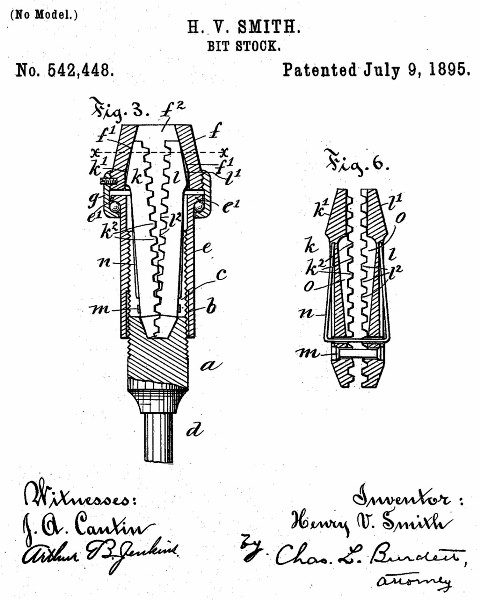 |
Group VI - These fine and useful braces have ball bearing chucks following the July 9, 1895 patent of Henry V. Smith. See the table of available braces listed under Group III above. The simplified first page is shown at left. For the most part the chuck shells have fared pretty well, with the principal deficit being loss of balls because the fixing screw often came undone, allowing the nose to unscrew and dumping the balls out. One never finds them all ... Fortunately, the screw is the common No. 8-32 size, and I have a supply of heat treated Allen head screws that I modify as replacements when necessary - there's no doubt about their authenticity because of the dimple remaining in the center of the replacement screw. A little Loc-Tite would solve the security problem, but wasn't available when these tools were made. Dr. Ronald W. Pearson has authored a fine book, The American Patented Brace 1829-1924, published by the Astragal Press, Mendham, New Jersey, in 1994 (hereafter simply Pearson). That year is almost prehistoric insofar as the Internet is concerned, and now Google and eBay have turned some of Ron's observations on their heads. For example, braces marked with the July 9, 1895 patent date of this design were never observed by Dr. Pearson or any of his sources. They're not common, but eBay has brought the ones that do exist out of hiding. And several of the patented devices used in this PEXTO Braces series did not find their way into Pearson. Not many of the available H.V.Smith patented braces have the jaws seen in the original patent drawing at left. The parent company, originally incorporated as the Peck, Stow & Wilcox Company, abbreviated to P.S.&W.Co. on the early braces and later becoming PEXTO, made all the braces with this style of ball-bearing chuck, and they're all marked with the July 9, 1895 patent date, even when the patent had expired. An exception is PEXTO-12, SOLD, with the chuck marked SAMSON, and which has a later ratchet. |
||||||||||
| Of the early
braces, some have have a rosewood wrist handle as seen at left and
nearly all have a ball
bearing quill whose pad is lignum vitae, usually mostly heartwood at
that. The wrist handle commonly has adjustable ferrules as shown
at left
(See PEXTO-
03; SOLD). Later braces have plain ferrules that were
simply
swaged into place; some were conical, others were cylindrical. A
couple of braces even have the hat-shaped ferrules that are the
unifying
characteristic of nearly all of Charles Amidon's companies' braces, but
one of them is marked with the date, June
11, 1901, for US Patent
No.675,917 that was awarded To George Allen - below, left. |
|||||||||||
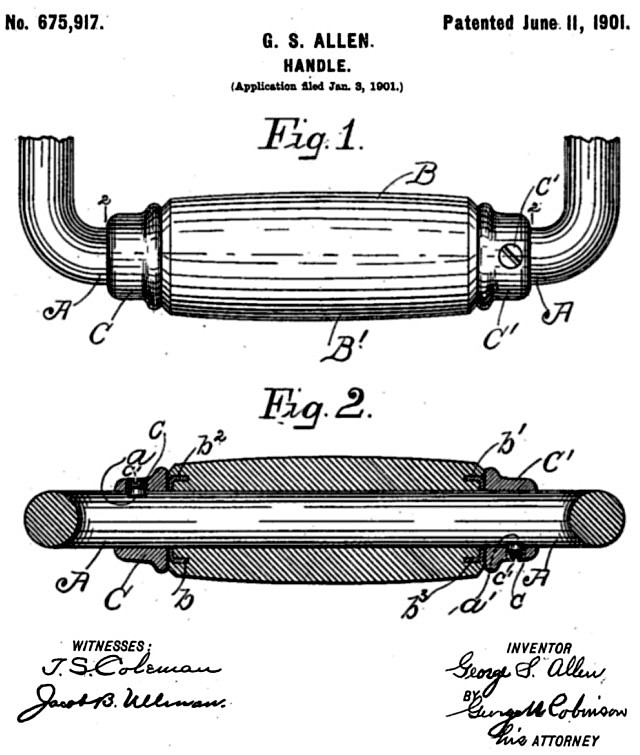 |
The actual
Allen-patent wrist handle was executed exactly as in the patent
drawings.
The screws only hold the ferrules; no adjustment is permitted, because they have cylindrical spigots that fit into holes drilled in the frame of the brace.
Note that the wood was machined first and then split, just like roller bearing races have long been made in "modern" times. The two halves do not fit back together if one half is rotated 180 degrees. The brass cups are curved into an elegant semi-doughnut shape.
|
||||||||||
|
